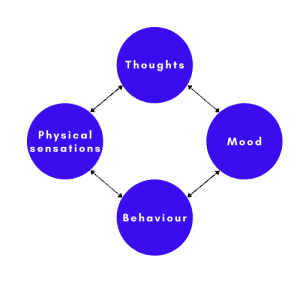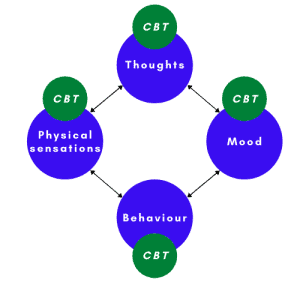
13 Nov What is CBT and how does it work?
Cognitive behavioural therapy (CBT) aims to teach people skills to master uncomfortable emotions by learning how to handle their thoughts and behaviours in new ways.
All emotions are made of four parts – thoughts (what goes through your mind), mood (the one-word label for how you feel e.g. happy, sad, anxious, happy), physical sensations (what you notice in your body e.g. changes in breathing rate, muscle tension, heart rate) and behaviour (what you do e.g. avoid something, stay in bed, walk towards something). Each part can affect the others.

When uncomfortable feelings like anxiety, depression, fear, shame or guilt are strong and persist, these can distort our thinking and discourage us from doing things that might be helpful to improve how we feel. In turn, that keeps the uncomfortable feelings going. The aim of CBT is to help people handle uncomfortable emotions by changing how they respond to their thinking and by learning new behaviours. It’s about breaking the unhelpful cycle between certain thoughts, behaviours and feelings.

CBT works by meeting with a therapist about every 1 to 2 weeks to learn skills to handle each part of the cycle above. A lot of people find they can benefit well in eight to twelve sessions. Some people may find more sessions helpful.
We use CBT because it is a practical, skills-focused way to help people improve how they feel. Several scientific studies have shown that CBT is helpful for people who experience anxiety disorders (such as Generalised Anxiety Disorder, Social Anxiety Disorder, Posttraumatic Stress Disorder, Panic Disorder, Obsessive Compulsive Disorder) and Major Depression.*
If this sounds helpful to you, then please feel free to contact our practice for an appointment on the details at the top of this page.
Click here for more information on common emotional difficulties.
*Research on CBT and its helpfulness with anxiety and depression can be found here:
https://www.ncbi.nlm.nih.gov/pmc/articles/PMC4610618/

